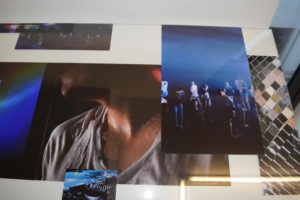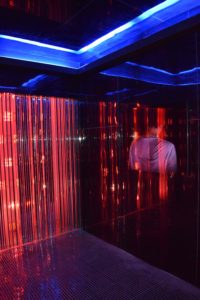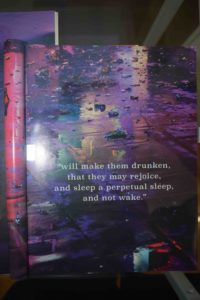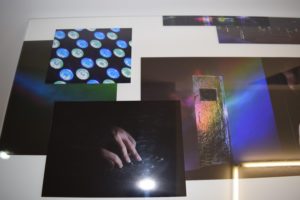
‘Do you go out a lot?’ This is one of the banal but frequently asked questions that people in their late-20s or 30s pose when we casually meet each other for the first time. ‘I used to when I was younger’, is the often heard answer. The reply tends to resonate with a melancholy that accompanies the happy memories of bygone parties and the levity of youth, which is what we were unknowingly celebrating back then. His long-term research about the parties of the 1990s inform Beijing-based artist Chen Wei’s most recent body of work presented at Leo Xu Projects.

‘The Last Man’ turns every gallery visitor into a fortunate latecomer. What remains for us to see in the entrance space are fragments of a deserted party environment. Among the pieces are two photographs, one of a forgotten leather jacket on a hook and a larger one of multiple disco balls on the floor of a bar. There is also a mysterious little dark room with weakly flickering coloured lights and a tiled dance floor. The light staggers and shines on and off a life-size photograph of a sweaty guy in a white T-shirt who has his back turned to us. It would be seriously unfortunate to miss the chance to see him.

Like the set of a movie or play, the exhibition unfolds over the three floors of the gallery. More and more details of mostly abandoned discos come to the fore. Light, mirrors, reflective materials such as polished steel or shiny tiles are present in photographs or as installations. ‘The Last Man’ manages just fine without descriptive texts. On the upper floor Wei provides showcases familiar to us from institutional exhibitions; here we see the usual book titles, magazine cut-outs and test prints that document the process of making of the artist’s “real” work. Wei’s showcases, however, are all about showing off the manipulative power of the photographic image.
The snapshot appearance of Wei’s photographs is deceptive. In fact, he stages each of them as carefully as, say, Johannes Vermeer would have staged his still-lifes. Wei’s dramatic staging of the light and the figures could have been learnt from old hands like Caravaggio or modern day masters like Wong Kar-wei. A favourite work in the exhibition is a photograph of a group of people frozen in a moment on a dance floor. Floodlights are shining on their young, benumbed bodies. In the air hangs the promise of something truly awesome or absolutely terrifying. Staging to and fro, the fate that awaits these people, can’t be foreseen.

Wei’s stagings provide a space on which you can project your memories and fantasies. It made me think of the novel Candy (2003) by Shanghai-based writer Mian Mian. Her book was in part a recollection of her experience of being an adolescent in urban China in the 1990s. Loaded with literary energy, the writer conveys how difficult it was to keep up with the pace of the change that was taking place, especially in the cultural field. Twelve years later, the situation seems to have calmed down, or to be in the process of calming down, like the guy pictured in Wei’s Disco #1004 (2015). Wei has staged the craving for the good old times, for the moments in which everything seemed perfect: the lover, the high, the light, the friends, the escape and so on and so forth.
‘Chen Wei – The Last Man’, November 14 – January 24, 2016, Leo Xu Projects, Shanghai
